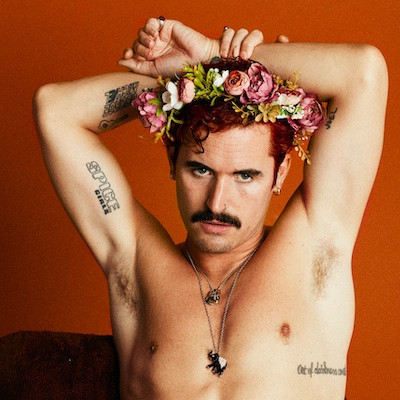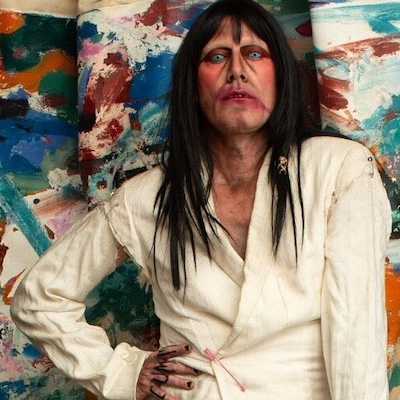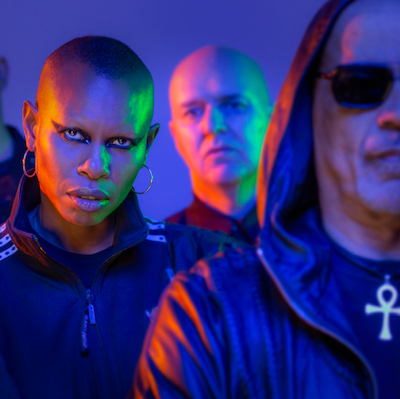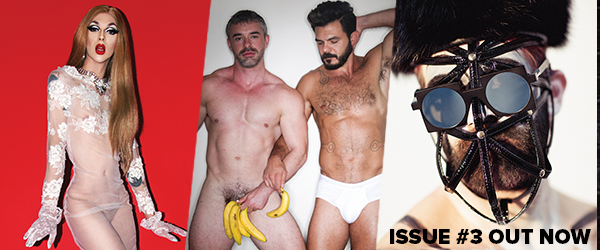
Ahead of the release of his third album Cabin Fever, Tom Aspaul invited us into the surreal, emotional, and often psychedelic journey that inspired it. While rooted in that heady experience, the album still shimmers with direct, glistening summer pop. What began as a Midsommar getaway spiraled into an unfiltered confrontation with grief, identity, and existential chaos—all soundtracked by ABBA, Olivia Newton-John, and Liza Minnelli. We caught up with the innovative pop architect to talk about making music from mayhem, the power of women, and why you might want to skip the acid.
Tom, Cabin Fever is out on May 19th! Congratulations. There are so many moods here for an album that was inspired by a very specific experience—something that happened to you on a trip to Sweden for Midsommar.
Yeah, I came away from that trip, obviously, using trip in the sense of…
A double entendre.
Yes! I came away feeling really weird and a little bit… I had just finished my tour. The sequence of events was so intense—I’d been in New York, did a sold-out show, it was overwhelming in a good way. I’d never toured the States before. Then I thought it would be smart to relax by going to Sweden with my friend for Midsommar. We’d planned it, booked a cute little cabin—it all seemed so lovely and quaint. And then it was anything but relaxing. We accidentally took way too much acid and… look, the thing I worry about when promoting this album is that I don’t want to glamorize substance use. It’s serious. We were really naive about LSD. People take shrooms or smoke weed and no one bats an eye, but LSD is heavy. That said, if you think back to the ’60s and ’70s—it inspired so much music, film, photography, and poetry.
So you were looking for a creative sabbatical?
I went into it thinking it would be a lovely, creative, relaxing trip. But we completely messed up the dosage, and I didn’t feel normal for a week. The first few hours were hell—I had horrible hallucinations, lost all sense of time and identity. I vomited, which helped a bit, and eventually it mellowed into something trippy and beautiful. But to get there, we had to go through complete chaos.
We were in this cabin in the Stockholm archipelago. Our Airbnb host lived further up the island, and Midsommar is a huge deal in Sweden—so family members were arriving by boat all day. Apparently, at one point I walked up to someone and said, “I don’t know who I am.” And we didn’t plan properly—everything shuts for Midsommar, so we had no food or drink. The hosts were amazing, though. They brought us wine, cake, fruit—no judgment, just complete kindness. At one point they even invited us to the family sauna. We declined.
From about 4 p.m. onward, it became a very beautiful experience. Matthew, my friend, is a therapist, so he basically started a session with me. We talked about everything—adolescence, coming out, gender identity, relationships. It got very deep. And we were still dressed in white with flower crowns—it was so pagan and unsettling. At one point I thought Matthew was the devil.
Later that evening, we got into a boat with a bowl of nuts, wine glasses, and Olivia Newton-John playing. It felt like The Talented Mr. Ripley. And then, of course, Matthew slipped and cut his arm open. So… very on-brand for the whole experience. We were all wearing white and we were just on the boat. And then Matthew slipped and the glass smashed and he cut all of his arm open.
My God.
And I don’t know if you’ve ever seen blood when you’re on LSD, but it is the scariest thing I’d ever seen. And we could see the neighbors on one of the other islands calling. And in our drug addled minds, we were like, they’re calling the police. So we sailed back to the shore and I ran up to the main house and I was like, you’ve got to help us. There’s been an accident. And all the wine had mixed into the blood at the bottom of the boat and it was just the messiest situation. And the host, she literally, she didn’t give a shit. She was cleaning out the blood, getting rid of all the nuts, all the glass. And she just did it in about two minutes. And then she’s like, come up to the house, I’ll patch you up. She puts stereo strips on Matthew’s arm. And then after that and everything had settled down, we were like, who is this woman?
I don’t do any psychotropics. Last time I did anything was like 15 years ago—I thought the CIA had taken my photo on the Palm Springs Aerial Tramway and were going to arrest my ex and me.
So we’ve all been there! That was literally while we were still in the throes of it all. When I got to the airport, I just started making notes of everything.
In the track Midsommar, it sounds like you’re talking directly to Matthew. Did you already know this would become part of the album?
No, not at all. I’m just glad we were stupid enough to film ourselves—because the audio quality on iPhones is great. You can hear Matthew’s voice in the song—he says, “You better make some good pop music out of this.” We have this friend, Katie, who’s done psychedelics before, so we called her. She helped calm us down—“It’s gonna run out. Drink some water. Stay by the lake.” That line you hear is from a video I sent her live from Sweden. We were like, “This is the most ridiculous thing that’s ever happened to us.” I thought about putting more of it on the album, but that little clip kind of says it all: We’re fucked. We don’t know how long this is gonna last.
It also seems like there’s this recurring presence of strong women throughout the album—whether in That Girl or ’70s Angels. You’ve mentioned Barbra Streisand being an influence, but how did that shape the emotional or sonic journey of the record?
It’s really interesting you picked up on that, because I hadn’t actually put two and two together in that way. But yeah—the original idea of going to Sweden was because me and Matthew are huge ABBA fans. We wanted to go to the ABBA Museum, then head to an island and just listen to ABBA. That was part of the whole relaxation plan, since I was coming off tour. We’re especially obsessed with the women from ABBA—it’s a big part of our friendship. We send each other pictures of Frida or Agnetha all the time. It’s just a thing we do.
I also made a playlist called ’70s Angels, which had Barbra Streisand, Olivia Newton-John, Nicolette Larson—just all these amazing women. Barbra and Olivia both had long careers, but some of the music I included was very specific to the ’70s. It had that summery, sparkly, singer-songwriter vibe with acoustic guitar and soft-focus glamour. It ended up being the perfect soundtrack to the experience.
And then our Airbnb host—this total mother figure—literally saved us. She brought us food, offered us a sauna, patched up Matthew, cleaned up all the mess… she was incredible. We talked a lot about how much we love women and how we truly wouldn’t survive without them. Katie, the friend we called, helped us through it too—so women really became a central force throughout the whole trip.
And that bled into That Girl, which came from another moment. A boat pulled into the harbor, full of these gorgeous, glowing, young Swedish girls, all just having the time of their lives. We looked at each other and said, “Wouldn’t it be amazing to be one of them?” Just carefree, living your best life. I’m 38, Matthew’s 41, so we were sitting there watching these 20-somethings, thinking—maybe this is wrong—but thinking it must be so easy for them to go through life like that. But then also, that comes with a lot of difficulty in the way they’re treated by men. Specifically straight men.
And other women……..
Yeah. And other women. It just brought up all these conversations—about how, when we were in our early 20s, I had absolutely zero confidence. In dating, in how I looked, in my sexuality. I used to think if you’re straight, everything’s just easier—the world is built for that, and you can move through it more effortlessly. It was actually a kind of throwaway moment. Matthew said, “I’d love to be that girl, you know?” And that became a song.
It also feels like you’re talking about being on the outside—watching these women, but from a queer perspective. Gay people, queer people, we’re naturally observers in so many ways. And taking LSD or any psychedelic is such an internal observational experience too.
Yeah, for sure. Like I said, Matthew’s a therapist who specializes in sexuality and LGBT issues, so naturally the conversation always steers that way. We were talking about past relationships, open relationships—whether we’re into that or not. And honestly, when you’re on LSD, the only thing you can really do is sit and talk. Also, my grandmother had passed away. She was a big part of my upbringing and I absolutely adored her. She died while I was on tour. I had a gig in Barcelona, flew home, was with her in the hospital through to the end, and then flew to Berlin the very next day. It was really, really hard. And we talked about that a lot.
I do think that’s why my trip took such a dark turn—because I was still processing that grief. Or not processing it, really. It all came out. You become so aware of your mortality on LSD, and I felt terrified. I think it was all connected to that. I wrote about thirty songs for this album, and at least two were specifically about my nan. Neither ended up on the final tracklist, but it was cathartic to write them. I love those songs. My producer Gil was just like, “Let’s go with something else,” which was totally fine. But yeah—it’s been a lot. And it took a really long time to get the album just right. I wanted it to be a balance of, yeah, let’s talk about Midsommar and LSD in Sweden, but also let’s include universal stuff—being cheated on, being the third wheel, open relationships. That’s what life looks like for a lot of us.
It also feels like there are other songs on the album that are personal in a different way—like Cabaret. I know you go-go dance, was that track influenced by your own experience?
Cabaret is actually about Sweden again. Cabaret is based on a very specific hallucination I had about Liza Minnelli. I had this dream during the trip—sounds insane saying it out loud—where Liza Minnelli was putting on a show just for us. The thing is, the sun never really set there, so we lost all sense of time. You’d nap randomly during the day and have these super vivid dreams. That one stuck with me. And obviously I connected it back to Cabaret—the film from 1972—which fit the whole vibe of the music we were listening to.
The song became a metaphor. I came to Sweden looking to relax, but what I got was so much more—these intense, revealing conversations. So, I used Cabaret to represent that: a series of performances, one after the other, each moment like its own act in the show. As for the dancing—I started go-go dancing about a year later, so it didn’t influence the writing. But it did pay for the mixing and mastering. Honestly, if it weren’t for go-go dancing, the album wouldn’t sound as good.
You’ve already released some strong music videos for the album—and they all seem to revolve around travel or searching. Whether it’s you in Las Vegas dressed as a king, or in a sauna, or cruising in a kind of dreamy haze.
Yeah, I wanted all the visuals to feel like part of a trip—or a hallucination. With Cabin Fever, I’m in a sauna, though you can’t really see that—there are rose petals, my eyes are red, it’s very surreal. The Las Vegas one for Drama is more grounded but still weird—it was inspired by The Last Showgirl, the Pamela Anderson film. In that, her show’s canceled and she just walks the Strip looking fab. I imagined I was in a medieval-themed show that got canceled, and now King Henry VIII is wandering around the Nevada desert.
I also did a visualizer for That Girl with an artist from Perth—all my notes were basically “make it as trippy as possible.” And I just filmed something for Cabaret with this amazing Cypriot drag queen. I’m not in it at all—she’s lip-syncing the track. The whole thing is red and dreamy, like Cabin Fever. The idea is that each video feels like a vignette—something half-remembered from a dream or a hallucination.
Location seems to be a recurring theme in your work. Even back with Thessaloniki on your last album Life in Plastic, there’s always been a kind of touristic thread—like you’re documenting places you pass through.
Yeah, I guess so. The first album was very rooted in where I’m from—the Black Country in the West Midlands. It had all these references to local roads and landscapes. Very specific. Then with Life in Plastic, I was drawing from Europop, and I’d lived in Greece for a while. Thessaloniki just made sense to write about—it would’ve felt silly not to include it.
The third album, though, that wasn’t planned. I didn’t go to Sweden thinking I’d write a whole record about it. It just… happened. I didn’t realize that trip would end up being such a strange and inspiring moment in my life.
I’m someone who loves to travel, and I’m lucky my job lets me perform in different cities across Europe—and hopefully Mexico later this year. I try to make the most of it, because it won’t last forever. My life at home is honestly quite suburban, very admin-heavy. There’s not a ton to write about when I’m just doing emails and running my business. But when I travel, that’s when the good stuff happens. You meet people, miss flights, take acid—whatever. It’s always more inspiring. And honestly, it’s just a great excuse to shoot a video somewhere beautiful.
You’ve got tour dates coming up—Canada, Utrecht, the UK, etc. What’s your plan visually? What’s it going to look like
That’s the funny part—I’m still figuring out how to bring the Midsommar/Sweden vibe to life onstage. For the UK shows, I’m working with a friend who’s a set designer and specializes in florals. We’re planning some stage pieces involving flowers. Outfit-wise, I did red last time, so I’m thinking blue—maybe a jumpsuit? That’s all swirling in the back of my mind.
I also just shot the promo visuals—it’s me on a giant horse. A bit cliché, but it fits the idea of a journey. And it also nods to my mum’s side of the family, who are Romany gypsy travellers. Last year, I went on a pilgrimage in France where thousands gather to honor Saint Sarah—they carry her statue into the sea on horseback. It was stunning. I’m not religious, but the energy of it was unforgettable. That experience really stayed with me and ended up inspiring the tour imagery.
A pilgrimage.
Exactly. Maybe I’ll call the tour that. I haven’t decided yet—Cabin Viva Life is also in the running. But I’ve got everything booked and the poster’s shot. Once the album’s out, I’ll announce it all in late June.
I know you’ve answered this before as someone we’ve featured and followed closely, but Loverboy Magazine is named after the hit Mariah Carey song. So—can you share a moment or something meaningful about Mariah to you?
Oh my God, where do I begin? I’m a lamb—I’d say a moderate lamb. I’ve seen her three times. One really cool moment: I saw her at the ball drop in Times Square on New Year’s Eve in 2005, right at the peak of The Emancipation of Mimi. She did the “We Belong Together” remix and it was insane. So New York. So dramatic. It was absolutely freezing, and she was incredible. I’ll never forget it.
Pre-Save Cabin Fever on Spotify Order Cabin Fever on Vinyl
Interview by George Alley








